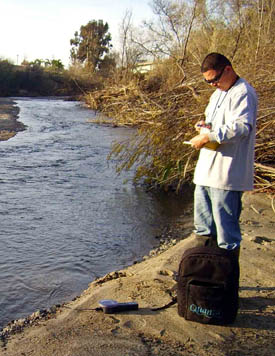Groundwater Management Plan - The San Juan Basin has a drainage area of over 111,000 acres and includes Oso Creek, Trabuco Creek, Horno Creek, Chiquita Canyon, Canada Gobernadora and Bell Canyon. The basin is currently managed by several agencies: the San Juan Basin Authority (SJBA), Municipal Water District of Orange County (MWDOC), California Regional Water Quality Control Board- San Diego Region (RWQCB) and the State Water Resources Control Board. The SJBA is a joint powers authority designed to carry out and oversee water resource development of the San Juan Basin. The SJBA is comprised of the following member agencies:
- Santa Margarita Water District (SMWD)

- Moulton Miguel Water District (MNWD)
- South Coast Water District (SCWD)
- City of San Juan Capistrano (CSJC)
The San Juan Basin is categorized as a subterranean flowing stream, thus water extraction from the basin falls under water rights regulation of the State Water Resources Control Board. Currently, SJBA retains the right to withdraw 8,026 AFY (acre feet per year) until 2035, but can be expanded to 10,702 AFY dependent upon the approval from Department of Water Resources. In order to keep in accordance with the given permits, SJBA conducts annual water level and water quality monitoring.
Facilities located within the San Juan Basin include 13 active groundwater wells, and a desalter plant; seven of the wells fall under the Municipal category, and the remaining six are under desalter operations. Currently, the greater part (90%) of the municipal groundwater is pumped for domestic use. SJBA makes it a primary goal to produce and use data to determine how to efficiently use the basin as a water storage facility and to increase the use of groundwater pumping for domestic uses. Currently, there are no active groundwater storage programs in the San Juan Basin.
The water quality of the San Juan Basin ranges from good to poor. The lower basins are deep however contain brackish water and require treatment, while the shallow upper subbasin has lower TDS (total dissolved solids) concentration. Monitoring wells, as well as the current production wells help measure water levels and electric conductivity which helps determine the amount of various constituents found in the water. It is alleged that the bulk of the salt content in the groundwater comes from marine sediments found to underlie much of the basin. Treatment for pumped groundwater is provided by the Desalter; which currently operates at about 2,075 AFY. In 2035, San Juan Capistrano’s lease of the Groundwater Production Plant is set to expire, and thus will require cooperation in sharing production capacity with neighboring agencies.
Groundwater Monitoring – In 2004, the San Juan Basin Authority (SJBA) developed a phased plan to maximize the use of local ground and surface water within the San Juan Creek Basin.
The first phase was completed in completed in 2004 and included the production of new wells and a desalter facility - the Groundwater Recovery Plant (GWRP). Under its completion, Santa Margarita Water District (SMWD) is able to operate under a permit issued by the State Water Resources Control Board, granting SMWD the right to divert up to 8,000 acre-feet of water per year for municipal purposes.
As part of its mitigation program, the San Juan Basin Authority (SJBA) developed a joint groundwater monitoring program with Santa Margarita Water District (SMWD) and South Coast Water District (SCWD). This program is designed to satisfy mitigation recommendations and release an annual report based on the collection of surface water, groundwater, biotic and climate data gathered in the field, which is also supplemented with previously existing data from reliable sources.
Due to the conclusion of negligible impacts of Phase 1, the SJBA has filed two petitions with the State Water Resources Control Board (SWRCB). The petition for change was filed to amend annual monitoring of groundwater levels to periods of dryer than normal years, and to terminate annual vegetation monitoring. The petition for extension of time was filed to extend project implementation for another 15 years, or until 2025. Both petitions were filed with the understanding that the data has shown evidence of little to no impact on the San Juan Basin, and will continue to have no significant effects.